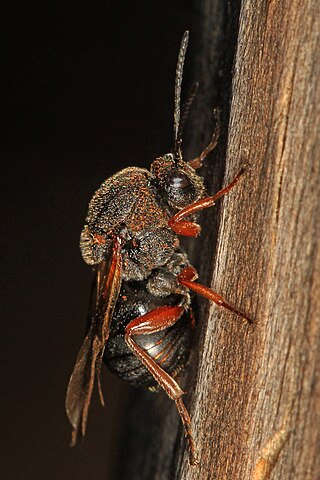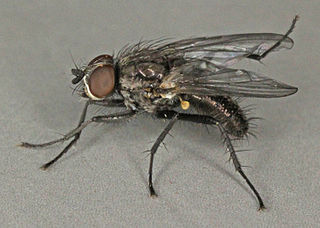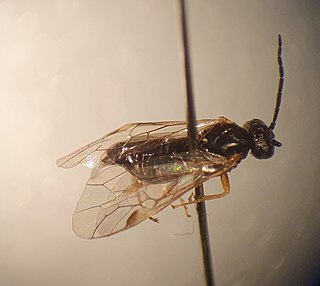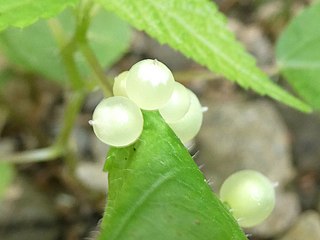Galls or cecidia are a kind of swelling growth on the external tissues of plants. Plant galls are abnormal outgrowths of plant tissues, similar to benign tumors or warts in animals. They can be caused by various parasites, from viruses, fungi and bacteria, to other plants, insects and mites. Plant galls are often highly organized structures so that the cause of the gall can often be determined without the actual agent being identified. This applies particularly to insect and mite plant galls. The study of plant galls is known as cecidology.

Gall wasps, also traditionally calledgallflies, are hymenopterans of the family Cynipidae in the wasp superfamily Cynipoidea. Their common name comes from the galls they induce on plants for larval development. About 1,300 species of this generally very small creature are known worldwide, with about 360 species of 36 different genera in Europe and some 800 species in North America.

Cecidomyiidae is a family of flies known as gall midges or gall gnats. As the name implies, the larvae of most gall midges feed within plant tissue, creating abnormal plant growths called galls. Cecidomyiidae are very fragile small insects usually only 2–3 mm (0.079–0.118 in) in length; many are less than 1 mm (0.039 in) long. They are characterised by hairy wings, unusual in the order Diptera, and have long antennae. Some Cecidomyiids are also known for the strange phenomenon of paedogenesis in which the larval stage reproduces without maturing first. In some species, the daughter larvae consume the mother, while in others, reproduction occurs later on in the egg or pupa.

The nettle pouch gall develops in leaf veins, leaf petioles, flower stalks and sometimes the stem of Urtica dioica and Urtica urens. This structure is caused by the gall midge or gnat Dasineura urticae, also spelled Dasyneura urticae. Synonyms are Perrisia urticae and Cecidomyia urticae.

Dasineura crataegi, the hawthorn button-top gall-midge, is a dipteran gall-midge. It causes the hawthorn button-top gall, which develops in the terminal shoots of common hawthorn, Crataegus monogyna Jacq., Midland hawthorn C laevigata (Poir.) DC and their hybrid, C × media Bechst. Synonyms are Perrisia crataegi and Cecidomyia crataegi.

Chirosia betuleti is a species of fly, which causes knotting gall in ferns. The gall develops in the terminal shoots of ferns, such as broad buckler fern, male fern, lady fern, and ostrich fern.

The goldenrod gall fly, also known as the goldenrod ball gallmaker, is a species of fly native to North America. The species is best known for the characteristic galls it forms on several species in the Solidago, or goldenrod, genus. The fly's eggs are inserted near the developing buds of the plant. After hatching, the larvae migrate to an area below the plant's developing buds, where they then induce the plant's tissues to form into the hardened, bulbous chamber referred to as a gall. E. solidaginis’s interactions with its host plant(s) and insect, as well as avian, predators have made it the centerpiece of much ecological and evolutionary biology research, and its tolerance of freezing temperatures has inspired studies into the anti-freeze properties of its biochemistry.

Cydia servillana is a moth of the family Tortricidae which forms galls on the young shoots of willow. It was first described by Philogène Auguste Joseph Duponchel in 1836.
Dasineura auritae is a gall midge which forms galls on the leaves of sallows and their hybrids. It was first described by Ewald Heinrich Rübsaamen in 1916.
Rabdophaga clausilia is a gall midge which, depending on the source, forms galls on the leaves of willows, or is an inquiline living in the galls of a Rabdophaga species, or a predator. It was first described by Johann Jacob Bremi-Wolf in 1847.

Dasineura carbonaria is a species of gall midges in the family Cecidomyiidae. It forms galls on Euthamia graminifolia.

Euura proxima is a species of sawfly belonging to the family Tenthredinidae. The larvae feed on the leaves of willows, creating galls. It was described by Jean Guillaume Audinet-Serville in 1823. The species was placed in the genus Euura in 2014 and was previously known as Nematus proximus and Pontania proxima.
Euura bridgmanii is a species of sawfly belonging to the family Tenthredinidae. The larvae feed on the leaves of sallows. It was first described by the entomologist Peter Cameron in 1883.
Euura vesicator is a species of sawfly belonging to the family Tenthredinidae. The larvae feed internally in a gall on the leaves of purple willow and its hybrids. It was first described by Johann Jacob Bremi-Wolf in 1849.
Euura herbaceae is a species of sawfly belonging to the family Tenthredinidae. The larvae feed internally in a gall formed on the leaves of dwarf willow and polar willow. Galls of E. aquilonis are similar and the larvae need to be examined to tell them apart.

Dasineura fraxini is a gall midge which forms galls on the leaves and petioles of ash. It was first described by Johann Jacob Bremi-Wolf in 1847.
Rabdophaga rosacea is a species of gall midge that creates rosette galls on roses found in the central plains of North America.
Dasineura acrophila is a gall midge which forms galls on the leaves of ash. It was first described by Johannes Winnertz in 1853 and is found in Europe.
Dasineura plicatrix is a species of gall midge, an insect in the family Cecidomyiidae, found in Europe. It was described by the German entomologist Friedrich Hermann Loew in 1850. The larvae feed within the tissue of bramble leaves, creating an abnormal growth known as a plant gall.

Dasineura investita, the wood nettle gall midge, forms a gall that grows on the wood nettle plant Laportea canadensis It was described in 2016 and is caused by a midge in the family Cecidomyiidae. The galls form on the petiole, upper leaf, leaf midrib, on leaf veins, between leaf veins, flower, stem. They are oval globose 4-5 mm by 8-12 mm pale, red, white, to green translucent.There are two generations a year, the full grown larva from the autumn generation overwinters in the central chamber of the gall. The genus Dasineura is a vary large one with many gall forming species.

















